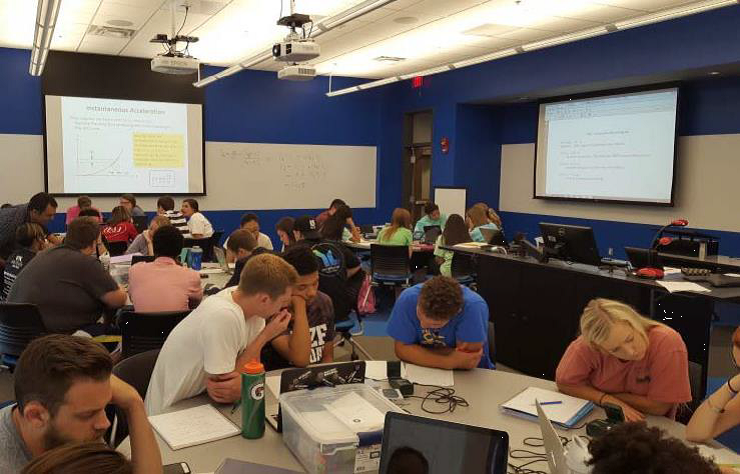In recent years, a new approach to teaching introductory physics has been making news, showing promising results and earning rave reviews from students. For some time we have wanted to try out this new approach, known as Technology Enabled Active Learning, or TEAL. Last year, we got our chance, following the construction of a special-purpose classroom. This is our biggest new initiative in undergraduate education in many years, and the results so far have been spectacular.
 TEAL is an approach to teaching based on the principle that students learn best from each other. TEAL employs a technologically enhanced classroom environment to facilitate interactions among students and between students and faculty. In a TEAL classroom, the instructor gives a short lecture to introduce concepts, which students immediately demonstrate and absorb through hands-on, interactive exercises and experiments. Students typically work at tables in small groups, facilitated by the instructor and assistants. Multiple video cameras and projectors make it possible for the instructor and students to communicate with each other, observe each others’ progress, and share ideas and data from any part of the room. Each group uses a computer to collect and analyze data.
TEAL is an approach to teaching based on the principle that students learn best from each other. TEAL employs a technologically enhanced classroom environment to facilitate interactions among students and between students and faculty. In a TEAL classroom, the instructor gives a short lecture to introduce concepts, which students immediately demonstrate and absorb through hands-on, interactive exercises and experiments. Students typically work at tables in small groups, facilitated by the instructor and assistants. Multiple video cameras and projectors make it possible for the instructor and students to communicate with each other, observe each others’ progress, and share ideas and data from any part of the room. Each group uses a computer to collect and analyze data.
TEAL and related approaches were originally developed more than 15 years ago, as an alternative to the traditional large-lecture format of most introductory physics courses. Since then, TEAL has spread to other fields and has been adopted at a rapidly growing number of universities. A series of studies have demonstrated the efficacy of TEAL-like approaches in a range of introductory science and math courses, with significantly higher student performance and satisfaction as notable outcomes.
A major step in developing a TEAL course in introductory physics at UK was the construction of a special-purpose classroom. With support from the College of Arts and Sciences, a 54-seat classroom was built to our specifications just in time for the Fall 2016 semester. The classroom contains six 9-seat tables, each of which accommodates three groups of three students, and is equipped with state-of-the-art electronics, video, and communications technology.
While the classroom was under construction, Prof. Brad Plaster spent an intense semester and summer developing a TEAL version of PHY 211 and 213, a two-semester sequence of courses taken mainly by biology and health science majors. He observed TEAL classrooms at other universities, talked extensively with the instructors, and collected and incorporated their best practices. With the help of Teaching Assistants Alina Alexandrova, Danielle Schaper, and Mohsen Nasseri, Plaster designed, procured, and built a full set of hands-on exercises and experiments. He met regularly with a faculty committee to discuss ideas and issues associated with the development of the course. The course went live in Fall 2016.
Students' end-of-semester evaluations were full of praise for Plaster and the TEAL format, and gave the course a higher overall rating than any other introductory level course we have ever offered:
- "This class was great. I love the TEAL version of physics. It made the class a lot more hands-on and easier to learn. I like how we work problems and worksheets in class every day. I also like the fact that the lab is integrated into the lecture."
- "Unlike other core science classes at UK, I really felt like the goal of this class was to help me LEARN physics and stimulate my interest in the subject rather than memorize it. Initially I dreaded the class, but the way it was presented and the way that the class was structured made me feel less intimidated. I felt like the group work really helped my problem solving skills."
This kind of response, for a rigorous, demanding, required course that is dreaded by many students, is extraordinary.
An even more startling outcome of the course was that female students significantly outperformed male students. The “gender gap” in traditional-format introductory physics courses is well documented, with most studies showing that men outperform women at a statistically significant rate. For example, when Plaster last taught PHY 211 as a large-lecture course, men scored an average of 4.7% higher than women on exams. This time around, the gap was reversed, with women outperforming men by 9.9%. Improvements in women’s performance in a TEAL format have been observed in previous studies (though not to this degree), and have been attributed to the use of “interactive engagement methods that promote in-class interaction, reduce competition, foster collaboration, and emphasize conceptual understanding.”
Last April, in recognition of his success in developing UK’s first TEAL Physics course, Plaster received the Innovative Teaching Award of UK’s College of Arts and Sciences. (He previously received the A&S Outstanding Teaching Award in 2013.)
This fall we are offering two sections of PHY 211, and hope to extend the effort to other 200-level courses in coming years. As other departments at UK develop their own TEAL-format courses, Plaster’s PHY 211 will serve as a model, or perhaps as an ideal to which they can aspire.
